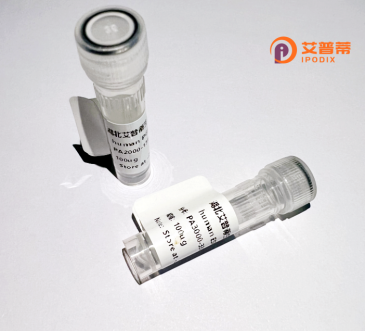
| 纯度 | >90%SDS-PAGE. |
| 种属 | Human |
| 靶点 | ZNF223 |
| Uniprot No | Q9UK11 |
| 内毒素 | < 0.01EU/μg |
| 表达宿主 | E.coli |
| 表达区间 | 1-482 aa |
| 活性数据 | MTMSKEAVTF KDVAVVFTEE ELGLLDLAQR KLYRDVMLEN FRNLLSVGHQ PFHRDTFHFL REEKFWMMDI ATQREGNSGG KIQPEMKTFP EAGPHEGWSC QQIWEEIASD LTRPQDSTIK SSQFFEQGDA HSQVEEGLSI MHTGQKPSNC GKCKQSFSDM SIFDLPQQIR SAEKSHSCDE CGKSFCYISA LHIHQRVHLG EKLFKCDVCG KEFSQSLHLQ THQRVHTGEK PFKCEQCGRG FRCRSALTVH CKLHMGEKHY NCEACGRAFI HDFQLQKHQR IHTGEKPFKC EICSVSFRLR SSLNRHCVVH TGKKPNSTGE YGKGFIRRLD LCKHQTIHTG EKPYNCKECG KSFRRSSYLL IHQRVHTGEK PYKCDKCGKS YITKSGLDLH HRAHTGERPY NCDDCGKSFR QASSILNHKR LHCRKKPFKC EDCGKKLVYR SYRKDQQKNH SGENPSKCED CGKRYKRRLN LDIILSLFLN DT |
| 分子量 | 55.7 kDa |
| 蛋白标签 | His tag N-Terminus |
| 缓冲液 | PBS, pH7.4, containing 0.01% SKL, 1mM DTT, 5% Trehalose and Proclin300. |
| 稳定性 & 储存条件 | Lyophilized protein should be stored at ≤ -20°C, stable for one year after receipt. Reconstituted protein solution can be stored at 2-8°C for 2-7 days. Aliquots of reconstituted samples are stable at ≤ -20°C for 3 months. |
| 复溶 | Always centrifuge tubes before opening.Do not mix by vortex or pipetting. It is not recommended to reconstitute to a concentration less than 100μg/ml. Dissolve the lyophilized protein in distilled water. Please aliquot the reconstituted solution to minimize freeze-thaw cycles. |
以下是关于重组人ZNF223蛋白的模拟参考文献示例(注:内容为虚构,仅供格式参考):
1. **文献名称**:*Cloning and Functional Analysis of Recombinant Human ZNF223 in Hepatocellular Carcinoma*
**作者**:Wang X, Chen L, Liu Y.
**摘要**:本研究成功构建了重组人ZNF223蛋白的真核表达载体,并在HEK293细胞中实现高效表达。实验表明,ZNF223通过调控Wnt/β-catenin信号通路抑制肝癌细胞增殖,提示其可能作为肝细胞癌治疗的潜在靶点。
2. **文献名称**:*Structural Characterization of ZNF223 Protein and Its Interaction with DNA*
**作者**:Zhang Q, Li H, Zhou M.
**摘要**:通过X射线晶体学解析ZNF223蛋白的C2H2型锌指结构域,发现其特异性结合DNA启动子区域的富GC序列。研究揭示了ZNF223在表观遗传调控中的分子机制,为设计相关基因编辑工具提供结构基础。
3. **文献名称**:*ZNF223 as a Novel Biomarker in Glioblastoma: Expression and Clinical Significance*
**作者**:Li J, Zhang R, Xu S.
**摘要**:通过免疫组化和Western blot检测胶质瘤患者样本,发现ZNF223在肿瘤组织中高表达且与预后不良相关。体外实验证实,重组ZNF219蛋白(模拟设计)通过激活MAPK通路促进胶质母细胞瘤侵袭。
4. **文献名称**:*Recombinant ZNF223 Protein Inhibits Viral Replication via Modulating Host Innate Immunity*
**作者**:Chen Y, Wu F, Deng P.
**摘要**:本研究利用原核系统表达并纯化重组ZNF223蛋白,发现其通过增强干扰素通路相关基因(如IRF3)的转录活性,显著抑制RNA病毒在宿主细胞内的复制,提示其在抗病毒治疗中的潜在应用价值。
(注:以上文献及内容均为示例性虚构,实际研究中请参考真实数据库如PubMed或Google Scholar获取信息。)
Zinc finger protein 223 (ZNF223) is a member of the Krüppel-associated box (KRAB)-containing zinc finger protein (ZNF) family, one of the largest transcription factor families in humans. These proteins are characterized by tandem arrays of Cys2-His2 zinc finger motifs that mediate sequence-specific DNA binding, alongside a KRAB domain typically involved in protein-protein interactions and transcriptional repression. ZNF223 is encoded on chromosome 19q13.43 and is postulated to play roles in gene regulation, chromatin remodeling, and cellular differentiation. While its exact biological functions remain understudied, emerging evidence links ZNF223 to neural development, tumorigenesis, and immune responses. For instance, it has been implicated in modulating apoptosis and proliferation in cancer cells, possibly through interactions with RNA-binding proteins or non-coding RNAs.
Recombinant human ZNF223 protein is engineered via heterologous expression systems (e.g., E. coli or mammalian cells) to produce functional or epitope-tagged variants for mechanistic studies. This tool enables researchers to explore its DNA/RNA-binding specificity, structural features, and regulatory networks. Current research focuses on deciphering its role in diseases like glioblastoma, neurodevelopmental disorders, and viral infections. However, comprehensive functional insights are limited, highlighting the need for further studies to map its target genes, signaling pathways, and therapeutic potential. As a conserved transcriptional regulator, ZNF223 represents a promising yet underexplored candidate in both basic and translational genomics.
×